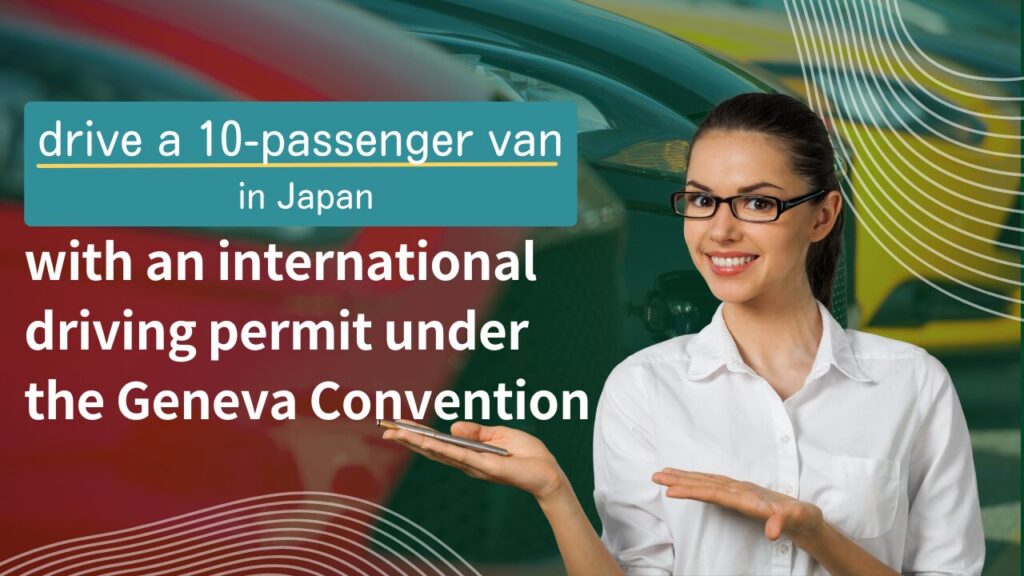
If you’re planning a trip to Japan with family or friends, renting a 10-passenger van—such as the popular Toyota Hiace—can be a convenient and comfortable way to get around. With just one vehicle, your entire group can travel together, making it ideal for long road trips or exploring the countryside with lots of luggage.
But one common concern is:
“Can I drive a 10-passenger van in Japan with my international license?”
“Do I need a special license to drive such a large vehicle?”
In this article, we’ll explain—clearly and simply—the rules for foreign drivers who want to operate a 10-passenger van in Japan.
Driving a Toyota Hiace in Japan: License Requirements for 8-Seater and 10-Seater Vans
Geneva Convention IDP + Correct License Category = OK!
Let’s start with the key point:
If you hold a valid International Driving Permit (IDP) issued under the 1949 Geneva Convention, you can legally drive a Toyota Hiace in Japan—but the required license category depends on whether you rent an 8-seater or 10-seater model.
| Hiace Model | Seating Capacity | Required License |
|---|---|---|
| Toyota Hiace (8-Seater) | Up to 8 passengers | IDP Class B (standard passenger vehicles) |
| Toyota Hiace (10-Seater) | Up to 10 passengers | IDP Class D (small bus license) |
This distinction is very important, as many travelers assume that both models can be driven with a standard B-class license.
the number of seats determines the license you need. Always check your IDP category before booking.
Renting an 8–10 Passenger Van in Japan
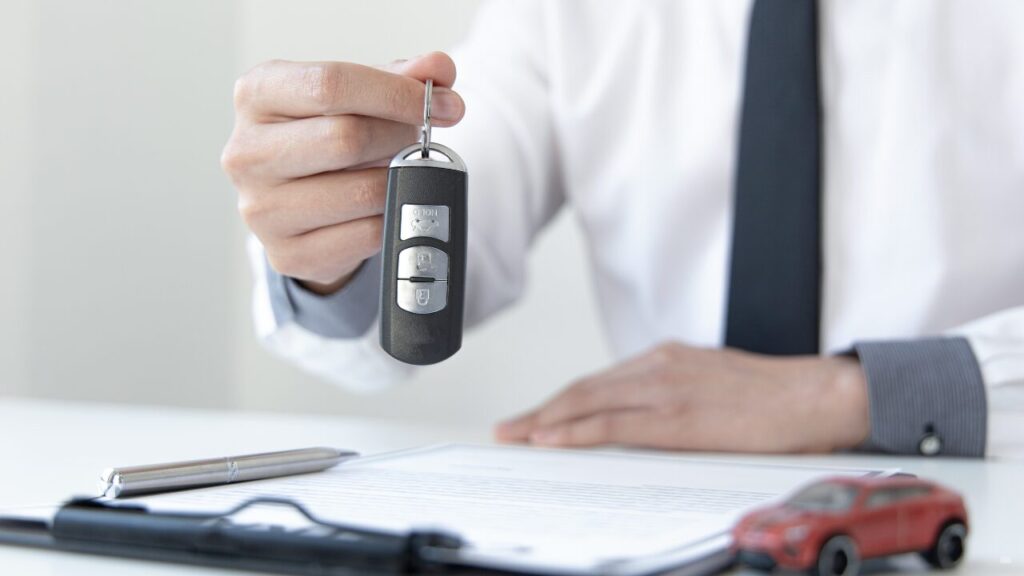
If you’re renting a Toyota Hiace or similar 8–10 passenger van for sightseeing, road trips, or family holidays in Japan, no special permits beyond the correct IDP are required. As long as your trip is for tourism purposes only, you are fully covered with the right license.
Exceptions where additional authorization is required:
- Commercial use (transporting passengers for a fee)
- Cargo delivery or logistics businesses
For personal or leisure travel, your Geneva Convention IDP (Class B or Class D, depending on vehicle size) is sufficient.
Important Reminder: Only the Geneva Convention IDP Is Accepted in Japan
Make sure your international driving permit is issued under the 1949 Geneva Convention.
Permits under the 1968 Vienna Convention are not valid in Japan.
You can check the official list of recognized countries on the websites of the Ministry of Foreign Affairs of Japan or the National Police Agency.
What Is the Geneva Convention? A Simple Guide to International Driving Permits Valid in Japan
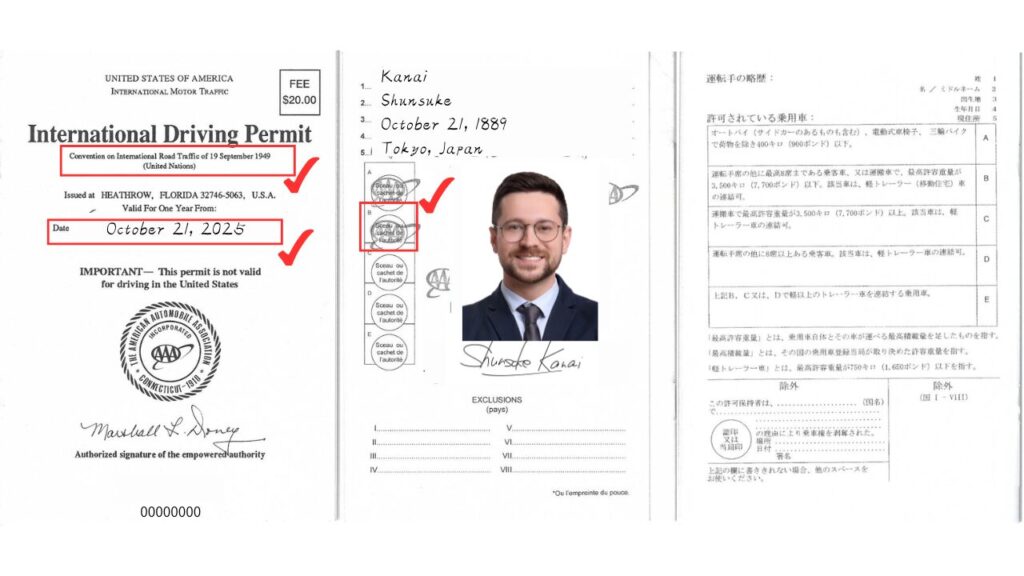
If you’re a foreign visitor planning to drive in Japan, you’ll need an International Driving Permit (IDP) issued under the 1949 Geneva Convention. This permit is widely issued by many countries and is recognizable by its gray, booklet-style paper format.
What Is the Geneva Convention?
The Geneva Convention on Road Traffic, signed in 1949, is an international treaty that aims to standardize driving rules and promote mutual recognition of driver’s licenses across member countries.
If your home country is a signatory of the Geneva Convention, and you meet certain conditions, you are legally allowed to drive temporarily in Japan with a valid IDP.
Countries Where the Geneva Convention IDP Is Accepted in Japan (as of 2025)
If your IDP is issued in one of the countries listed below—and complies with the 1949 Geneva Convention—it is valid for driving in Japan:
- United States (USA)
- Canada
- Australia
- United Kingdom (UK)
- France
- Germany
- Italy
- Philippines
- Thailand
…and many more
The issuance process and validity period of an IDP may vary by country. Before applying, it’s recommended to check with your local embassy or issuing authority to ensure you receive the correct type of permit for use in Japan.
Types of Licenses That Are Not Valid in Japan: What to Avoid

Before driving in Japan, it’s crucial to understand which types of licenses are not accepted. Using an invalid license can lead to legal trouble or problems with insurance coverage—so be sure to check carefully in advance.
International Driving Permits issued under the 1968 Vienna Convention
Examples: Poland, Belgium, and others
→ Japan is not a signatory to the Vienna Convention, so IDPs based on this treaty are not valid in Japan.
Card-style “International Driving Permits”
→ The only valid IDP format in Japan is the gray, paper booklet issued under the 1949 Geneva Convention.
Card-type versions are often unofficial or designed for use in other countries and are not accepted in Japan under any circumstances.
Driver’s licenses from non-Geneva Convention countries, even with translations
→ Even if a license is accompanied by a Japanese or English translation, if it’s from a non-member country, it cannot be used to drive in Japan.
Can You Drive in Japan Without an International Permit?
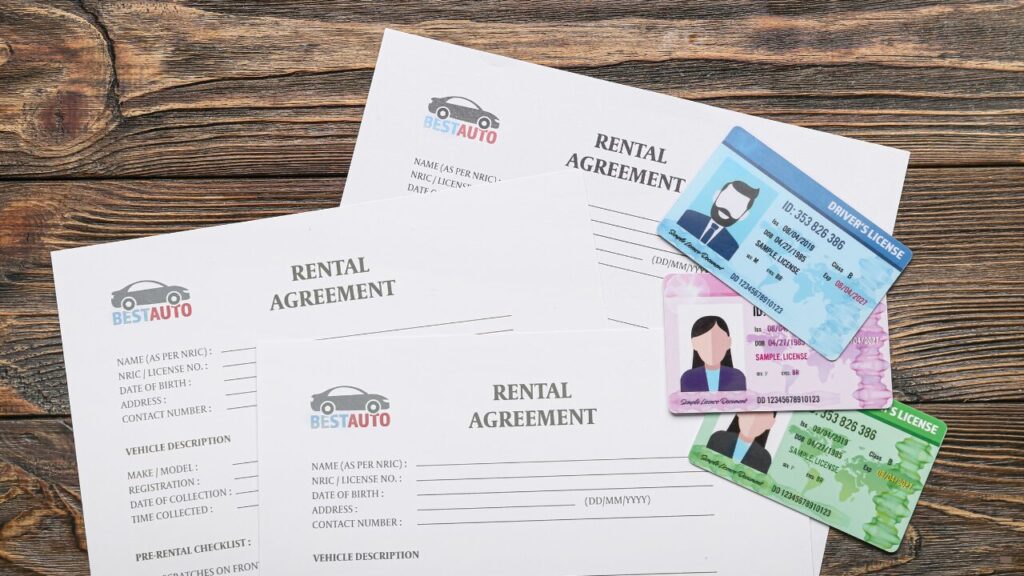
While many travelers assume that an International Driving Permit (IDP) is always required, Japan does allow certain foreign licenses to be used without an IDP—thanks to the Translation System.
What Is the Translation System?
Under Japanese law, drivers from specific countries can legally operate a vehicle in Japan by carrying:
- A valid foreign driver’s license, and
- An official Japanese translation of the license
Countries Eligible for the Translation System (as of 2025):
- Switzerland
- Germany
- France
- Monaco
- Taiwan
If you hold a valid license from one of these countries or regions, you are legally allowed to drive in Japan without an international permit, as long as you carry the required Japanese translation.
Understanding these rules helps ensure a smooth and legal driving experience during your stay in Japan. If you’re unsure whether your license qualifies, it’s always best to check with your local embassy or the Japan Automobile Federation (JAF) before your trip.
How to Obtain an Official Japanese Translation of Your Driver’s License
To legally drive in Japan using the Translation System, the Japanese translation of your driver’s license must be issued by an officially recognized authority. Translations from unapproved organizations will not be accepted.
Only translations issued by the following organizations are recognized as valid in Japan:
You can apply for a translation through the JAF official website.
Be sure to check processing time and fees in advance, as these may vary depending on your country of license issuance.
Important Notes About the Translation System
When using the Translation System to drive in Japan, you must comply with the following conditions:
By following the proper procedures and securing an official translation from a recognized agency, you can ensure a legal and stress-free driving experience in Japan. Always double-check requirements with the JAF or your local embassy for the most up-to-date details.

Yes, You Can Drive an 8–10 Passenger Van in Japan!
Explore Japan by Road with a Toyota Hiace
According to Japanese traffic laws, vehicles with a seating capacity of 8 to 10 passengers can be driven with the correct driver’s license category. This means that even the popular Toyota Hiace (8-seater or 10-seater model) can be legally driven by international travelers in Japan—provided you have the right license.
Why the Toyota Hiace Is Ideal for Road Trips in Japan
- Comfortable seating for up to 10 passengers – perfect for large families or group travel
- Spacious rear luggage area – fits large suitcases, strollers, or sports equipment with ease
- Great for sightseeing and road trips – enjoy smooth travel across Tokyo, Osaka, Kyoto, or the Japanese countryside
License Requirements for Driving a Toyota Hiace in Japan
To drive a Hiace legally, you’ll need one of the following:
- International Driving Permit (IDP) under the 1949 Geneva Convention
- Japanese driver’s license, or a Japanese translation of your valid foreign license (for countries like Switzerland, Germany, France, Belgium, Monaco, and Taiwan)
And remember:
- 8-Seater Toyota Hiace → IDP Class B license required
- 10-Seater Toyota Hiace → IDP Class D license required
With the right license, renting a Toyota Hiace in Japan is the best way to enjoy a safe, comfortable, and convenient group trip. Whether you’re traveling with family or friends, the Hiace offers the freedom to explore Japan at your own pace.Belgium, Monaco, and Taiwan)

Drive in Japan with Confidence|Support Services from ASAHI MOTORS

For many first-time visitors to Japan, the idea of driving in a foreign country can feel a little intimidating. That’s why ASAHI MOTORS offers a range of dedicated support services tailored to meet the needs of international travelers.
ASAHI MOTORS’ Services for Foreign Drivers:
- English-friendly reservations and customer support
- Vehicle delivery to airports or hotels for added convenience
- Child seat rentals – ideal for families traveling with kids
- ETC card rentals for easy access to Japan’s expressways
- Beginner-friendly rental guide in English to walk you through the process
With these helpful services, ASAHI MOTORS makes it easy for foreign visitors to enjoy a safe, smooth, and stress-free driving experience in Japan.
Whether you’re planning a scenic road trip or a family vacation, you can rent with confidence and focus on making lasting memories.
Quick Recap: License Requirements for Driving a Van in Japan
Thinking about renting a Toyota Hiace (8–10-seater van) for your trip to Japan? Here are the key rules every international driver should know:
Accepted Licenses in Japan
- International Driving Permit (IDP) under the 1949 Geneva Convention
- Required for most foreign visitors
- Category B license → valid for 8-seater vans
- Category D license → required for 10-seater vans
- Domestic license + official Japanese translation
- Applies to drivers from Switzerland, Germany, France, Monaco, and Taiwan
- Translation must be issued by JAF or your home country’s licensing authority
Licenses Not Accepted in Japan
- IDPs issued under the 1968 Vienna Convention
- Card-style international licenses (plastic card format)
⚠ Important:
You must carry your original driver’s license at all times.
A translation alone is not valid for driving in Japan.
Some translations may include an expiration date—check the validity before your trip.
With the correct license, you can legally drive a Toyota Hiace 8-seater or 10-seater van in Japan, making it the perfect choice for family vacations, group travel, or road trips.
Enjoy a Road Trip in Japan with the Right License and Documents

Planning to drive in Japan? Great news—vehicles like the Toyota Hiace (8–10-passenger van) can be driven with a standard license, as long as you meet the correct requirements.
What You Need to Know:
- A Category B license allows you to drive an 8-seater Hiace
- A Category D license is required for a 10-seater Hiace
- Only the 1949 Geneva Convention IDP is valid in Japan—permits under the 1968 Vienna Convention will not be accepted
- Travelers from Switzerland, Germany, France, Monaco, and Taiwan can legally drive in Japan by using their domestic license with an official Japanese translation
Stress-Free Rentals for International Visitors
With ASAHI MOTORS, foreign drivers can easily rent a Hiace in Japan thanks to English support, insurance coverage, and straightforward booking.
Why Choose a Hiace Van for Your Trip?
- Perfect for families and group travel
- Spacious luggage capacity for suitcases and travel gear
- Comfortable, safe, and flexible travel without relying on trains or buses
With the right license and documents in hand, you can enjoy a comfortable, flexible, and worry-free road trip in Japan. Renting a Toyota Hiace 8–10-seater van gives your group the freedom to explore Japan’s stunning landscapes and must-see attractions at your own pace.



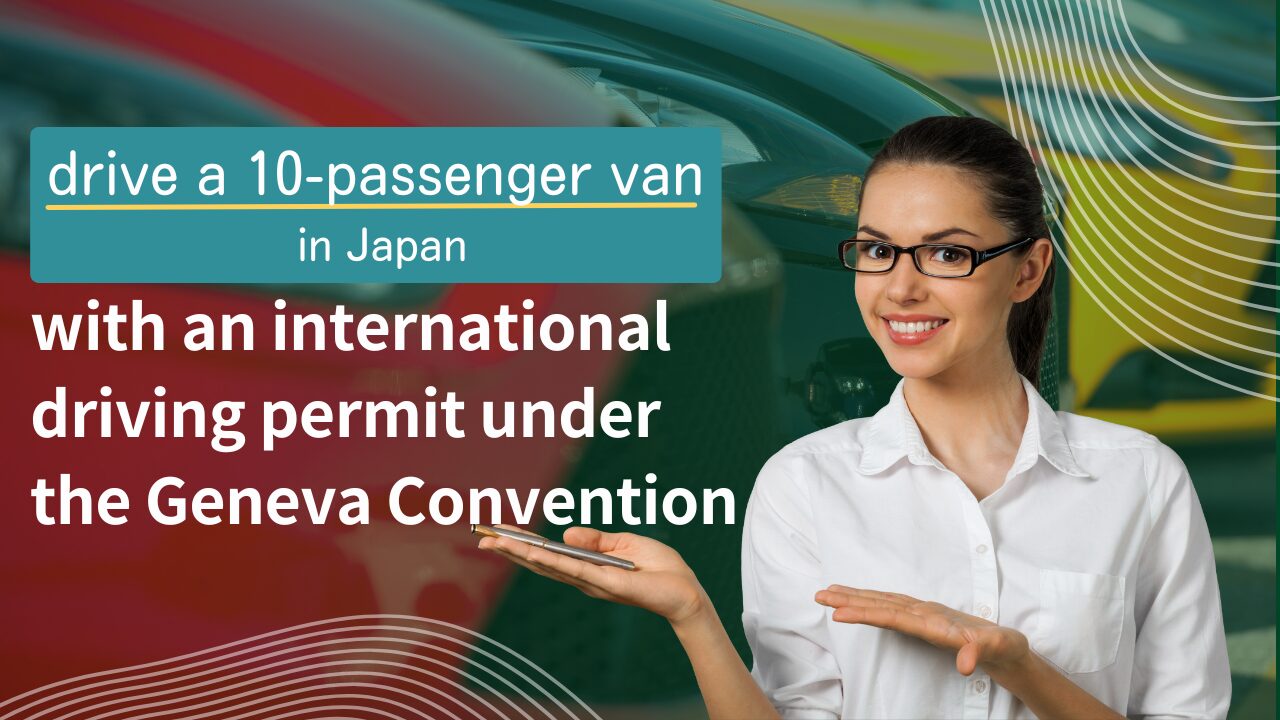


COMMENT